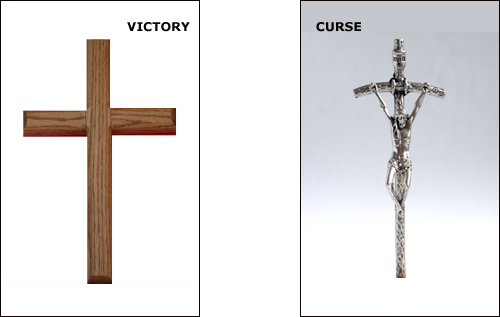
In our church stand two crosses.  One, the crucifix, shows Jesus in all of his tortured agony. The other stands gleaming white and empty, a potent symbol of the promise that in Jesus “death has lost its sting.” And as much as we profess faith in the victory, it is telling that the crucifix stands over the pulpit and the empty cross over the Lord’s Table; one signifies where we are, and the other signifies where we will be “when he comes again in glory.” Until then, this– the sixth word of Jesus from the cross– remains our hope.
One, the crucifix, shows Jesus in all of his tortured agony. The other stands gleaming white and empty, a potent symbol of the promise that in Jesus “death has lost its sting.” And as much as we profess faith in the victory, it is telling that the crucifix stands over the pulpit and the empty cross over the Lord’s Table; one signifies where we are, and the other signifies where we will be “when he comes again in glory.” Until then, this– the sixth word of Jesus from the cross– remains our hope.
Life is lived in tension between these two crosses, and that forces us, says Hauerwas, “to stay in the almost unbearable present moment where Jesus is.” This suffering, as we have pointed out, is the passive lot of those of us who are left wanting more. “There in the agony of the ‘sufferings of this present age,” writes Gerhard Forde, “he cried, ‘Father, forgive them for they know not what they do.’ Is that not enough? John’s Gospel put it only slightly differently: “It is finished!” This is what we have, the basis of our faith that holds on, as David Ford says, during our overwhelming. “This overwhelming,” writes Hauerwas, “[allows] us to live not because we have answer to all the world’s troubles, but because God has given us a way to live without answers.” (88)
is lived in tension between these two crosses, and that forces us, says Hauerwas, “to stay in the almost unbearable present moment where Jesus is.” This suffering, as we have pointed out, is the passive lot of those of us who are left wanting more. “There in the agony of the ‘sufferings of this present age,” writes Gerhard Forde, “he cried, ‘Father, forgive them for they know not what they do.’ Is that not enough? John’s Gospel put it only slightly differently: “It is finished!” This is what we have, the basis of our faith that holds on, as David Ford says, during our overwhelming. “This overwhelming,” writes Hauerwas, “[allows] us to live not because we have answer to all the world’s troubles, but because God has given us a way to live without answers.” (88)
But before we grow our beards out, throw up our hands  and retreat into the mystery of 24/7 Eucharistic adoration, let us be clear about what we can say, because too often the “sufferings of this present age,” force pastors and theologians–and I am as culpable as anyone—to unanswered, unfinished speculation about the cross that subverts Jesus’ very cry. What’s worse, inveterate moralists across the political and theological spectrum want to turn this end into a beginning. “See,” it is argued, “Jesus did it all, now get going and do (or stop) xyz, because that can’t really be all there is to it.” Sadly, Hauerwas also drops the ball, as he, like so many others, puts the weight of “it is finished,” back on a continuum that, despite semantic word games, makes it anything but. He writes, “To be sure, he has come that we might be redeemed, but our redemption is but one movement in this drama of the beginning and end of time.” Oh, Alles klar;-)
and retreat into the mystery of 24/7 Eucharistic adoration, let us be clear about what we can say, because too often the “sufferings of this present age,” force pastors and theologians–and I am as culpable as anyone—to unanswered, unfinished speculation about the cross that subverts Jesus’ very cry. What’s worse, inveterate moralists across the political and theological spectrum want to turn this end into a beginning. “See,” it is argued, “Jesus did it all, now get going and do (or stop) xyz, because that can’t really be all there is to it.” Sadly, Hauerwas also drops the ball, as he, like so many others, puts the weight of “it is finished,” back on a continuum that, despite semantic word games, makes it anything but. He writes, “To be sure, he has come that we might be redeemed, but our redemption is but one movement in this drama of the beginning and end of time.” Oh, Alles klar;-)
This  is a tragic irony: the very words signifying an actual end to something are parlayed into motivational grist for the mill of the tortured soul. In this cruel reversal of a Pauline theme in Romans 7, the very Gospel that once promised life to me proved death. “It is finished,” becomes the law of “now it begins,” and we who are weary and heavy laden are subjected to the greatest bait and switch of all time.
is a tragic irony: the very words signifying an actual end to something are parlayed into motivational grist for the mill of the tortured soul. In this cruel reversal of a Pauline theme in Romans 7, the very Gospel that once promised life to me proved death. “It is finished,” becomes the law of “now it begins,” and we who are weary and heavy laden are subjected to the greatest bait and switch of all time.
In  direct and steadfast opposition to this, we never tire of insisting that “it is finished” means just that. Everything that ever needed to be done or ever will need to be done by us to be reconciled to God has been accomplished. He is in control. He is redeeming the world. We can not mess up His plan because it is finished. So we are free to live as people fully present in the “sufferings of this present age.” Living squarely in the shadow of the crucifix, and resting confidently on the finished work of our Savior, we are “always being prepared to make a defense to anyone who asks a reason for the hope that is in [us]” (1 Peter 3:15). In this hope, we wait, because although our end has not yet come, by faith, it is finished.
direct and steadfast opposition to this, we never tire of insisting that “it is finished” means just that. Everything that ever needed to be done or ever will need to be done by us to be reconciled to God has been accomplished. He is in control. He is redeeming the world. We can not mess up His plan because it is finished. So we are free to live as people fully present in the “sufferings of this present age.” Living squarely in the shadow of the crucifix, and resting confidently on the finished work of our Savior, we are “always being prepared to make a defense to anyone who asks a reason for the hope that is in [us]” (1 Peter 3:15). In this hope, we wait, because although our end has not yet come, by faith, it is finished.

COMMENTS
2 responses to “325 Days of Lent: "It is finished"”
Leave a Reply













Wonderful, Jady. Such a help to me.
This is excellent stuff Jady.
Jesus was still in the grave when the cross was emtied of him. So the empty cross cannot signify the resurrection. That would be the empty tomb. So we still need to mentally hang a dead Jew on that empty cross don´t we now…